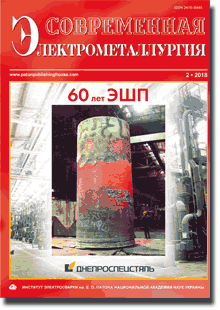| 2018 №02 (01) |
DOI of Article 10.15407/sem2018.02.02 |
2018 №02 (03) |

Electrometallurgy Today (Sovremennaya Elektrometallurgiya), 2018, #2, 19-27 pages
Metallurgical characteristics of large slabs, produced by electroslag remelting
Zhou-hua Jiang1, Xu Chen1, Xin Geng1, Qiang Yu2
1School of Metallurgy, Northeastern University.
2School of Information, Northeastern University. Wenhua Rd., Heping district, Shenyang, Liaoning, 110819, PR China. E-mail: jiangzh63@163.com
Abstract
Three types of furnaces for electroslag remelting have been designed and manufactured for producing slabs of 50 ton weight with a maximum 960×2000 mm cross section. Production of slabs of more than 20 grades of steels of 640,760 and 960 mm thicknesses, as well as plates from 20 up to 410 mm thickness was organized. Presented are the main peculiar features of ESR furnaces, technology of the process, properties of slabs and super-thick ESR plates, used for hydropower stations. A low-frequency power source, bifilar connection, mobile mould, shielding gases, secondary cooling, control of melting rate and other advanced technologies were used for ESR. The low content of hydrogen, oxygen and inclusions, as well as a good quality of the ESR ingot were obtained due to the technological process optimizing. As a sample of super-thick plates, used for hydropower stations, the thick plates S500Q/Z35 of 265 mm thickness were produced. Ref. 7, Tabl. 12, Fig. 8.
Key words: electroslag remelting; large slab; super-thick plate; steel for hydropower station; property; Z-direction
Received: 30.12.17
Published: 25.05.18
References
- Quansheng Wang, Guoguang Cheng (2006) Technical analysis on feasibility of WISCO 40 t ESR ingot project. Heavy Plate, 12(2), 21–25.
- Zhouhua Jiang, Yanwu Dong, Ximin Zang, Huabing Li (2011) The new development of special metallurgy technology for special steels. China Metallurgy, 21(12), 1–10.
- Zhouhua Jiang. (2000) Physical chemistry and transportation phenomena in electroslag metallurgy. Shenyang, The Northeastern University press, 19–21.
- Xin Geng (2009) Process technology and quality control for electroslag remelting large slab ingots. Shenyang, Northeastern University.
- Kazumi Ogino, Shigeta Hara, Takashi Miwa and Shinji Kimoto (1979) The effect of oxygen content in molten steel on the interfacial tension between molten steel and slag. The Iron and Steel Institute of Japan, 14(65), 2012–2021. https://doi.org/10.2355/tetsutohagane1955.65.14_2012
- Tatsuhiko Kusamichi, Teruo Ishii, Toshio Onoye, Kiichi Narita (1980) Effect of composition of slag on heat transfer characteristics in electroslag remelting process, Tetsu-to-Hagane. Ibid., 66(12), 1640–1649.
- Yanwu Dong, Zhouhua Jiang, Lianke Liang, Zhengbang Li (2011) Hydrogen permeability of slags containing calcium fluoride. Cent. South Univ. Technol., 18(4), 1063–1067. https://doi.org/10.1007/s11771-011-0804-5
